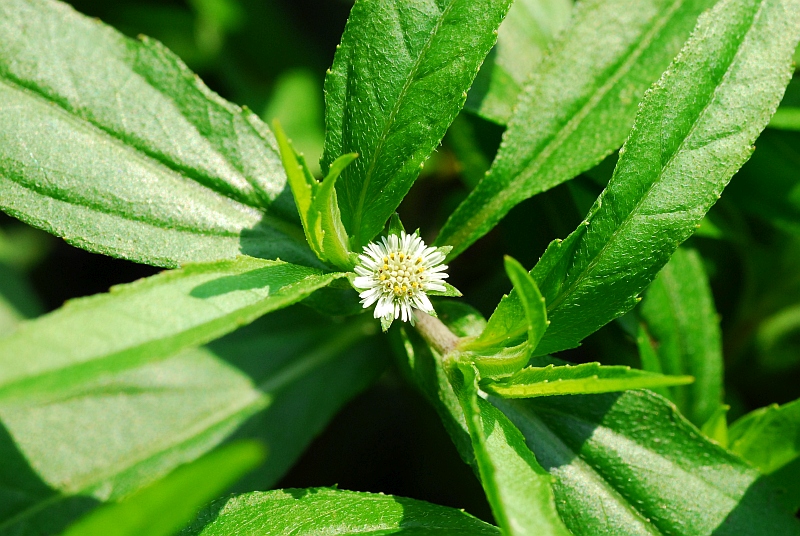Eclipta prostrata (L.) L.
Yerba De Tajo

Native
CC = 3
CW = -3
MOC = 81
© SRTurner
Eclipta prostrata (L.) L.Yerba De Tajo | |
 |
Native CC = 3 CW = -3 MOC = 81 |
© SRTurner |
|
Family - Asteraceae/Heliantheae Habit - Taprooted annual forb. Stems - Spreading to erect, to 75 cm, sometimes from a spreading base, sometimes rooting at the nodes, few- to many-branched, with fine longitudinal ridges and grooves, sparsely to densely pubescent with appressed-ascending hairs, especially toward the tip, sometimes glabrous toward the base, reddish or purplish in strong sun.
Leaves - Opposite, sessile or with a short, poorly differentiated petiole, the base slightly expanded and wrapping around the stem. Leaf blades 1-10 cm long, lanceolate, unlobed, narrowly angled at the base, tapered to a sharply pointed tip, the margins sparsely to densely and finely toothed and with short, stiff, appressed hairs, the surfaces sparsely to moderately pubescent with short, stiff, appressed hairs, these usually with a minutely expanded, somewhat resinous, pustular base.
Inflorescences - Solitary terminal and/or axillary heads or sometimes in small clusters of 2 or 3, the heads appearing short- to long-stalked, the stalks densely antrorse strigose, bractless. Heads - Radiate but sometimes appearing discoid. Disk 4-10 mm broad. Involucre 2-5 mm long, 3-5 mm in diameter, broadening as the fruits mature, cup-shaped to slightly bell-shaped, the bracts in usually 2 subequal series (the inner series sometimes slightly shorter than the others). Involucral bracts 10-12, green but with the basal half lighter and prominently several-nerved, mostly ascending at the tip, narrowly lanceolate to ovate, antrorse strigose externally, glabrous internally. Receptacle flat to shallowly convex, broadening as the fruits mature, the florets subtended by chaffy bracts, these narrowly linear, awnlike, and shed with the florets.
Ray flowers - Ray florets 20 to numerous in 2 or 3 series, fertile, pistillate, the 2-branched style exserted from the short tube at flowering, the corolla 1-3 mm long, relatively slender, notched or rounded at the apex, white, glabrous, not persistent at fruiting. Pappus absent. Disk flowers - Disc florets 15 to numerous, perfect, the corolla 1.0-1.5 mm long, white, the short tube not expanded at the base or persistent at fruiting, glabrous, the mostly 4 minute lobes glabrous, white. Stamens 4. Style branches with the sterile tip short-tapered to a bluntly pointed tip. Pappus absent or a minute rim or crown. Chaff to 3 mm long, translucent yellow, antrorsely barbellate.
Fruits - Achenes 2.0-2.5 mm long, wedge-shaped to somewhat triangular in outline, 3- or 4-angled, the surface usually appearing wrinkled or warty, straw-colored to nearly black, the tip minutely hairy and usually darker than the rest of the fruit.
Flowering - July - October. Habitat - Streambanks, sloughs, marshes, pond margins, ditches, fallow fields, wet areas. Lookalikes - None close. Broadly, Galinsoga quadriradiata. Origin - Native to U.S. and tropical areas worldwide. Other info. - This plant is quite prolific. It can grow on land or directly in the water. The stems often form roots from the nodes when floating in the water. The tiny white flowering heads and opposite leaves are good characteristics for identifying this species in the field. It is common throughout Missouri, and is also found throughout much of the continental U.S. except for the northwestern quadrant. Photographs taken at the Kansas City Zoo, 7-2-99 and off of Lee Rd 51, Lee County, AL., 10-7-04 (DETenaglia); also at Dresser Island Conservation Area, 8-13-2012, and Washington (MO) Riverfront Trail, Franklin County, MO, 9-20-2019 (SRTurner) |